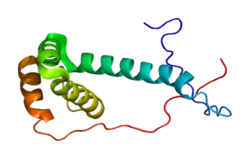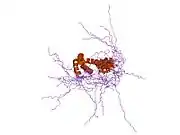PDCD5
Programmed cell death protein 5 is a protein that in humans is encoded by the PDCD5 gene.[4][5]
This gene encodes a protein expressed in tumor cells during apoptosis independent of the apoptosis-inducing stimuli. Prior to apoptosis induction, this gene product is distributed in both the nucleus and cytoplasm.
Once apoptosis is induced, the level of this protein increases and by relocation from the cytoplasm, it accumulates in the nucleus. Although its exact function is not defined, this protein is thought to play an early and universal role in apoptosis.[5]
References
- GRCh38: Ensembl release 89: ENSG00000105185 - Ensembl, May 2017
- "Human PubMed Reference:". National Center for Biotechnology Information, U.S. National Library of Medicine.
- "Mouse PubMed Reference:". National Center for Biotechnology Information, U.S. National Library of Medicine.
- Liu H, Wang Y, Zhang Y, Song Q, Di C, Chen G, Tang J, Ma D (Feb 1999). "TFAR19, a novel apoptosis-related gene cloned from human leukemia cell line TF-1, could enhance apoptosis of some tumor cells induced by growth factor withdrawal". Biochem Biophys Res Commun. 254 (1): 203–10. doi:10.1006/bbrc.1998.9893. PMID 9920759.
- "Entrez Gene: PDCD5 programmed cell death 5".
Further reading
- Bonaldo MF, Lennon G, Soares MB (1997). "Normalization and subtraction: two approaches to facilitate gene discovery". Genome Res. 6 (9): 791–806. doi:10.1101/gr.6.9.791. PMID 8889548.
- Chen Y, Sun R, Han W, et al. (2002). "Nuclear translocation of PDCD5 (TFAR19): an early signal for apoptosis?". FEBS Lett. 509 (2): 191–6. doi:10.1016/S0014-5793(01)03062-9. PMID 11741587. S2CID 26547410.
- Strausberg RL, Feingold EA, Grouse LH, et al. (2003). "Generation and initial analysis of more than 15,000 full-length human and mouse cDNA sequences". Proc. Natl. Acad. Sci. U.S.A. 99 (26): 16899–903. doi:10.1073/pnas.242603899. PMC 139241. PMID 12477932.
- Gevaert K, Goethals M, Martens L, et al. (2004). "Exploring proteomes and analyzing protein processing by mass spectrometric identification of sorted N-terminal peptides". Nat. Biotechnol. 21 (5): 566–9. doi:10.1038/nbt810. PMID 12665801. S2CID 23783563.
- Xu M, Cheng N, Gui L, et al. (2004). "The 5'-upstream region of human programmed cell death 5 gene contains a highly active TATA-less promoter that is up-regulated by etoposide". Gene. 329: 39–49. doi:10.1016/j.gene.2003.12.025. PMID 15033527.
- Beausoleil SA, Jedrychowski M, Schwartz D, et al. (2004). "Large-scale characterization of HeLa cell nuclear phosphoproteins". Proc. Natl. Acad. Sci. U.S.A. 101 (33): 12130–5. doi:10.1073/pnas.0404720101. PMC 514446. PMID 15302935.
- Gerhard DS, Wagner L, Feingold EA, et al. (2004). "The Status, Quality, and Expansion of the NIH Full-Length cDNA Project: The Mammalian Gene Collection (MGC)". Genome Res. 14 (10B): 2121–7. doi:10.1101/gr.2596504. PMC 528928. PMID 15489334.
- Liu D, Yao H, Chen Y, et al. (2006). "The N-terminal 26-residue fragment of human programmed cell death 5 protein can form a stable α-helix having unique electrostatic potential character". Biochem. J. 392 (Pt 1): 47–54. doi:10.1042/BJ20050688. PMC 1317663. PMID 16083422.
- Stelzl U, Worm U, Lalowski M, et al. (2005). "A human protein-protein interaction network: a resource for annotating the proteome". Cell. 122 (6): 957–68. doi:10.1016/j.cell.2005.08.029. hdl:11858/00-001M-0000-0010-8592-0. PMID 16169070. S2CID 8235923.
- Ma X, Ruan G, Wang Y, et al. (2006). "Two single-nucleotide polymorphisms with linkage disequilibrium in the human programmed cell death 5 gene 5' regulatory region affect promoter activity and the susceptibility of chronic myelogenous leukemia in Chinese population". Clin. Cancer Res. 11 (24 Pt 1): 8592–9. doi:10.1158/1078-0432.CCR-05-0039. PMID 16361542.
- Yang YH, Zhao M, Li WM, et al. (2007). "Expression of programmed cell death 5 gene involves in regulation of apoptosis in gastric tumor cells". Apoptosis. 11 (6): 993–1001. doi:10.1007/s10495-006-6714-6. PMID 16547588. S2CID 21178139.
- Olsen JV, Blagoev B, Gnad F, et al. (2006). "Global, in vivo, and site-specific phosphorylation dynamics in signaling networks". Cell. 127 (3): 635–48. doi:10.1016/j.cell.2006.09.026. PMID 17081983. S2CID 7827573.
- Wang N, Lu HS, Guan ZP, et al. (2007). "Involvement of PDCD5 in the regulation of apoptosis in fibroblast-like synoviocytes of rheumatoid arthritis". Apoptosis. 12 (8): 1433–41. doi:10.1007/s10495-007-0070-z. PMID 17468978. S2CID 21175365.
This article is issued from Wikipedia. The text is licensed under Creative Commons - Attribution - Sharealike. Additional terms may apply for the media files.



